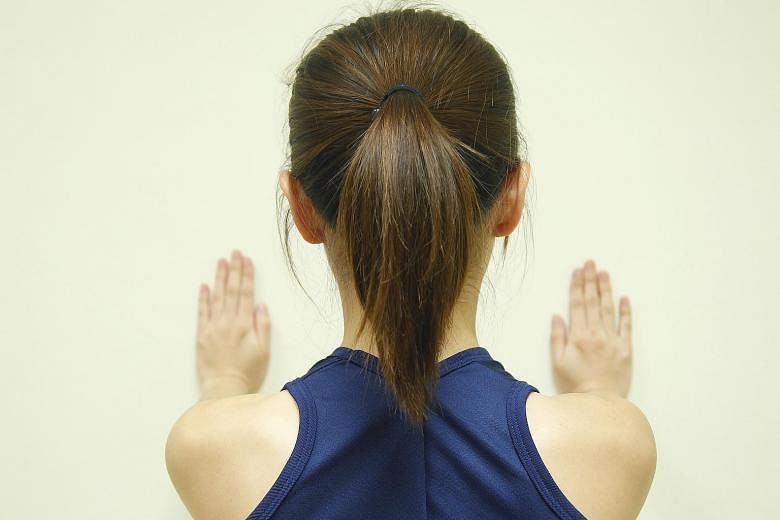As people age and start losing muscle mass, everyday activities like climbing the stairs and carrying bags of groceries become increasingly difficult. The good news is, there is an answer to these woes: resistance training.
It may seem counter-intuitive to build muscle mass when you hit middle age, but doing so can do a world of good.
In older adults, the loss of muscle mass can put them at higher risk of injury to muscles and joints, said Ms Pradha Rajoo, a senior physiotherapist at the National Healthcare Group Polyclinics.
Less muscle means less strength and mobility. That is where resistance or strength training can lend a helping hand. This is basically any exercise that makes one's muscles work harder than normal, said Ms Rajoo. It includes training with free weights, machines and bodyweight.
Resistance training is a form of exercise that remains popular all over the world. Dr Ong Joo Haw, a consultant sports physician at Khoo Teck Puat Hospital's Sports Medicine Centre, notes that a lot more patients are now interested in strength training.
The growing popularity of sports such as powerlifting has also led to more interest in the area, he said. It is a trend that looks set to stay, given Singapore's fast-ageing population.
Worldwide, resistance training remains hot. An online survey on the fitness trends for 2018 by the American College of Sports Medicine (ACSM) placed bodyweight training - using own weight as a source of resistance - at No. 4 on the list.
Strength training, which is the use of weight training to improve strength, was ranked No. 5. The ACSM report said strength training has remained a strong trend since its first survey in 2007.
-
Ways to strengthen muscles
-
•Do eight to 12 repetitions of a strengthening exercise such as bicep curls or knee straightening. Then rest. To achieve a strengthening effect for the muscles, do not do more than eight to 12 repetitions of a particular exercise. If you can do more than eight to 12 repetitions, it becomes an endurance exercise. But your muscle strength will not be increased.
•To progress with your strengthening exercises, increase the resistance or weight by 5 per cent or the number of sets of the repetitions. For example, if you can do two sets of eight repetitions easily, progress to three sets of eight repetitions.
•As there is no specific recommended time that one has to spend doing strengthening exercises, you should simply aim to cover all the major muscle groups in the body.
•Do strengthening exercises at least two times a week.
•Allow a break of one to two days in between your strengthening programme so that your muscles can rest and recover. During the break, work on your aerobic or flexibility exercises.
Source: MS PRADHA RAJOO, SENIOR PHYSIOTHERAPIST, NATIONAL HEALTHCARE GROUP POLYCLINICS
Using strength training to improve balance, coordination, force, power and endurance, to enhance a person's ability to perform activities of daily life, is also hot. This is known as functional fitness, which took the 10th spot on the list.
Many contemporary and innovative health fitness professionals incorporate some form of strength training into the comprehensive exercise routine for their clients and patients, said the report.
Dr Ong said resistance training is an integral part of any fitness programme, which should include aerobic training and flexibility training.
"The main purpose of it is to increase strength and build muscles, which improves body composition, increases basal metabolism and improves general fitness," he said.
Resistance training also helps to prevent injury.
"Most varieties of aerobic training carry an injury risk, both overuse and acute," said Dr Ong. "Thus, if one does not have a balanced programme that includes some form of resistance training to strengthen important muscles, the risk of injury during, for example, running or cycling, is increased."
As resistance training improves body composition and strength, these attributes will no doubt improve one's aerobic performance, he added. Simple resistance exercises such as wall push-ups, pull-ups or exercises with resistance bands can be done at home with minimal equipment.
Individuals who are new to exercise or have medical conditions should seek medical clearance before starting on any programme, and stop when symptoms such as dizziness, excessive breathlessness, chest pain or joint pain occur, said Dr Ong. Those who are new or not familiar with resistance training may experience delayed-onset muscle soreness, which occurs a couple of days after the exercise. "This is normal and should not be mistaken for injury," he said.
Resistance training helps us to perform everyday activities with more ease, said Ms Rajoo. Ultimately, the aim is to be able to lead an active and independent lifestyle, free of injury.
Top 10 fitness trends for 2018
1. High-intensity interval training: This involves short bursts of activity followed by a short period of rest or recovery. These exercise programmes are usually performed in less than 30 minutes.
2. Group training: These are designed to be motivational and effective for people at different fitness levels, with instructors using leadership techniques to help them achieve fitness goals.
3. Wearable technology: Fitness trackers, smartwatches, heart-rate monitors and GPS tracking devices help track the details about your workout, such as calories burned, speed and distance.
4. Bodyweight training: This uses minimal equipment, making it more affordable. Not limited to just push-ups and pull-ups, it allows people to get "back to the basics" with fitness.
5. Strength training: It is still a central emphasis for many health clubs. Incorporating strength training is an essential part of a complete exercise programme for all physical activity levels and genders.
6. Educated and experienced fitness professionals: Qualifications are becoming more important and a large number of organisations now offer various forms of health and fitness certification.
7. Yoga: Based on ancient tradition, yoga utilises a series of specific bodily postures practised for health and relaxation. This includes power yoga, yogalates, bikram, ashtanga, vinyasa and kundalini.
8. Personal training: More students are majoring in kinesiology. It shows that they are preparing themselves for careers in allied health fields such as personal training.
Education, training and proper credentials for personal trainers have become more important to the fitness facilities that employ them.
9. Fitness programmes for older adults: Some of these baby boomers have more discretionary income than people who are younger. Many health and fitness professionals are thus keen to create suitable programmes for older adults.
10. Functional fitness: This is a trend towards using strength training to improve balance and ease of daily living. Functional fitness and special fitness programmes for older adults are closely related.
SOURCE: AMERICAN COLLEGE OF SPORTS MEDICINE



